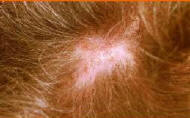Alopecia areata
Return to main page of alopecia return to page-2 of alopecia

Systemic lupus erythematosus (SLE)
SLE is a chronic autoimmune inflammatory disease affecting
collagen. It involves multiple systems of the body including
hair loss
Secondary syphilis
Secondary syphilis usually begins 2 to 8 weeks after chancre
type lesions appear. It can present with patchy hair loss,
mostly on the scalp and often elsewhere on the body. This
hair loss is often described as having a moth-eaten
appearance. High-risk clients should also be questioned
regarding past rashes, especially on the palms, soles, and
any chancroid lesions or condyloma. Diagnosis is serologic (VDRL
or rapid plasma regain [RPR]), and hair regrowth occurs
after penicillin therapy. Penicillin remains the first
choice, but if an allergy exists, intramuscular Rocephin (x
10 days), tetracycline, or doxycycline may be tried for 2
weeks.
Side effects of medications
Medications such as cytotoxic agents, colchicine, heparin,
oral anticoagulants, hydroxyurea therapy, vitamin A,
captopril, protease inhibitors such as indinavir and
nelfinavir, amphetamines, anticancer agents, gout
medication, isotretinoin (Accutane), lithium, male hormones,
propranolol hydrochloride (Inderal), and valproic acid (Depacon,
Depakene, Depakote), can all induce nonscarring hair loss.
Birth control pills
Women who lose hair while taking birth control pills may
have an inherited tendency for hair thinning. If hair
thinning occurs, a woman can consult her gynecologist about
switching to another birth control pill. When a woman stops
using oral contraceptives, she may notice that her hair
begins shedding two or three months later. This may continue
for six months when it usually stops. This is similar to
hair loss after the birth of a child.
Caustic chemicals
Anyone who curls, straightens, colors, or dyes their hair
may cause hair loss. Repeated exposure to these substances
can injury hair follicles, weaken hair, or even damage the
scalp. It is most often seen in African women, and
inflammation is not always obvious.
High fever or severe infection
Acute and some chronic illnesses may cause hairs to enter a
prolonged resting telogen phase (also known as telogen
effluvium). It is not uncommon to experience a higher
incidence of hair loss up to three months after high fever,
severe illness, or infection. This resting phase typically
resolves after several months and normal hair growth
rebounds when the growth cycle returns.
Other causes of hair loss
Other causes of hair loss include anemia, hypoalbuminemia,
malnutrition, Lichen planus, Staphylococcal folliculitis,
scleroderma, psoriasis, seborrhoeic dermatitis, menopause,
hypothyroidism, herpes zoster, and others.
Treatment Recommendations
The choice of therapeutic intervention for alopecia depends
on several factors:
Hypothyroidism
Thyroid replacement or adjustment as indicated
Fungal infection
Ketoconazole, oral antifungal agents such as griseofulvin (Grifulvin),
itraconazole (Sporanox), terbinafine (Lamisil), and
fluconazole (Diflucan) may be used. Oral steroids may be
necessary to decrease inflammation and scarring.
Hormone imbalance
If female androgen excess is suspected (hirsutism, acne) or
menses is irregular, check DHEA-S and free testosterone
levels first to rule out adrenal or ovarian cancer.
Once ruled out, consider spironolactone, flutamide, or
finasteride.
Spironolactone competes with testosterone and
dihydrotestosterone at the androgen receptor level.
Spironolactone 100 mg per day can be given in divided doses;
this dose may be increased to 200 mg.
Flutamide (Eulexin), an antiandrogen that blocks androgen
uptake and nuclear binding, is a very effective drug in
treating hyperandrogenism. Give 250 mg daily and monitor
hepatotoxicity.
Finasteride (Propecia) blocks the conversion of testosterone
to dihydrotestosterone. The plasma levels of testosterone
may increase during treatment, whereas the
dihydrotestosterone level decreases. Of utmost importance,
the patient should be aware that she must avoid pregnancy
during treatment with finasteride because of the potential
for causing ambiguous genitalia in a male fetus.
Drug-induced hair loss (effluvium)
Drugs that induce hair loss include antihypertensive agents,
anti-gout medications, etc. Consider tapering or
discontinuing the medication if untoward risks are low.
Chemotherapy
Recommend no
